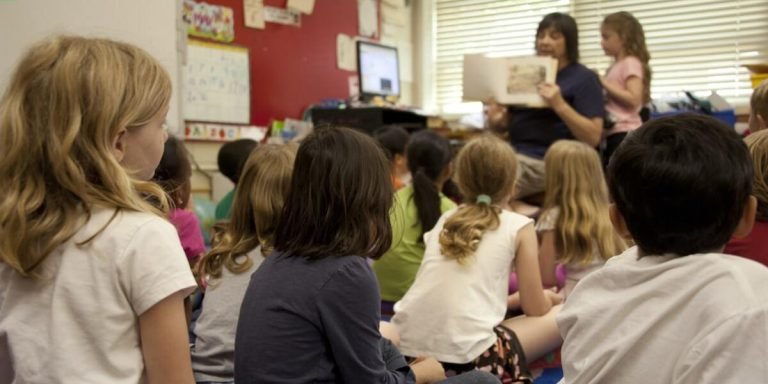Grants for Teachers: Unveiling the Opportunities to Boost Classroom Innovation and Learning.
Understanding the increasingly essential role of innovation in educational success, many institutions and organizations are offering grants for teachers. These financial aids aim to enhance classroom learning experience by providing resources to integrate advanced tools, technologies, or unique teaching methodologies. However, accessing these may seem daunting due to lack of information or awareness among educators.
This blog post aims at bringing into limelight such opportunities that can significantly contribute towards upgrading your child’s classroom environment – transforming it from a traditional education system into an interactive hub of creativity and cognitive growth. As parents and educators alike strive for improved student engagement with evolved teaching practices; support through these teacher-specific grants could pave the way forward.
Did you know?
In 2019, the National Education Association reported that up to 81% of teachers use their own money for classroom needs; yet there are numerous grants available specifically designed to aid educators in enhancing their teaching environments and methods.
Maximizing Grant Opportunities for Educator Advancement
The current educational landscape presents a myriad of opportunities for educators seeking to advance their careers and expand their knowledge base. Among these opportunities, grants have emerged as a powerful tool for enhancing pedagogical skills while easing the financial burden often associated with further education or innovative classroom projects. By understanding how to maximize grant possibilities effectively, teachers can uncover unique avenues towards professional development.
Grants for teachers come in various forms: from those aimed at funding specific research projects to others designed to aid continuing education efforts. The key is finding and seizing upon these chances efficiently – this requires thorough researching into available offers, acute awareness of application timelines and meticulously crafting proposals that emphasize your project’s importance or potential impact on student learning outcomes.
In recent years there has been an increase in organizations recognizing the value of investing in educator advancement programs through offering more targeted teacher-centric grants. This array gives way not only to traditional areas like curriculum design but extends also into emerging fields such as technology integration within instruction – thereby making it even more crucial for educators today than ever before.
Understanding the Application Process for Teacher Grants
The path to securing grants for teachers often begins with a clear understanding of the application process. With thousands of opportunities available at federal, state and local levels, knowing how to apply is integral in maximizing grant potential.
The next step involves identifying which type(s) best suits your needs as an educator advancing further into your field — be it classroom supplies, professional development courses or innovative teaching projects. Keep in mind the eligibility requirements such as specific grade level taught, location or subject focus while opting for one.
Once identified, create a compelling proposal explaining why you are eligible for this funding opportunity and what its impact will be on enhancing student learning experiences – both immediate and long-term benefits expected from it should stand out here.
This includes detailing carefully planned budgets depicting where exactly these funds would go if received – whether towards equipment purchasing, technology upgrades or curricular improvements among others; demonstrating prudent financial management skills also plays heavily towards achieving successful applications.
Documentation matters too! Many teacher grants require supporting documents like tax returns,to show proof of employment status within education sector before approving any allocation claim made against them – make sure all necessary paperwork’s assembled beforehand so nothing gets missed during submission rush hours!
Identifying Resources and Networks to Find Available Grants
Embarking on the journey of finding grants for teachers may seem daunting initially, but a plethora of resources and strong networks exist to make this process significantly smoother. To start off, let’s delve into how you can identify these helpful sources.
Firstly, online platforms should be your go-to option in today’s digital era. There are several websites dedicated exclusively towards providing information about the available educational grants like The U.S Department of Education or GrantWatch. These sites also offer assistance regarding application procedures thus easing out complexities involved with paperwork.
Secondly, leaning onto local school districts often harvest fruitful results too. They typically have an allocated budget for teacher advancements and therefore could provide direction about obtaining financial help from within their system itself.
Thirdly, don’t sideline professional teaching organizations as they frequently hold workshops or seminars providing insights about securing different kinds of grants whether federal or private ones.
Another impressive resource is community foundations which aim at supporting education locally via various grant programs intended primarily for educators’ advancement – reaching out to them won’t disappoint!
Lastly remember that networking plays a pivotal role here as well – connect extensively with fellow teachers who were successful in acquiring grants; their personal experiences coupled up with practical advice will surely illuminate your pathway forward.
Now that we’ve explored potential avenues where you might find insightful guidance related to “grants for teachers”, it’s time we dwelled on creating effective search strategies which would follow soon! Let 2023 be the year filled not just new challenges but bountiful opportunities!
Elevating Classroom Experiences through Educational Funding
In the dynamic field of education, grants designed specifically for teachers have become increasingly popular. These financial aids serve as a boon to educators dedicated to elevating classroom experiences through innovative techniques and tools. The crux lies in ensuring that these resources reach their potential users effectively.
Grants for teachers act as catalysts, enabling them to incorporate technology, undertake research-based projects or introduce novel teaching methodologies that might otherwise be inaccessible due to budget constraints. Furthermore, they imbue an element of motivation amongst educators motivated enough by seeing their classrooms transform into hubs of active learning.
Being aware of such possibilities can help parents and fellow-educators recognize avenues for augmenting student engagement levels too. With 2023 witnessing more digital integration within educational methods than ever before, tapping into this reservoir could prove beneficial on multiple fronts; providing enriched learning environments charged with creativity while fostering deeper bonds between students and academia at large.
Crafting Winning Proposals for Teaching Grants
Winning proposals for teaching grants don’t just materialize. Rather, they require a well-thought-out plan with attention to detail and more importantly – creativity.
To start off, understanding the eligibility criteria is paramount. Ensure that your school and project fit within these parameters before you set out on crafting your proposal.
Next comes research – an in-depth study not only about what defines successful grant applications but also specific requirements laid down by funding bodies or organizations offering these grants for teachers. Your efforts here could include gleaning through awarded grant examples online or connecting with former grantees to learn from their experiences.
Having done this groundwork helps make drafting your proposal less daunting as it gives a better sense of direction. Here’s where you bring together compelling narratives highlighting how procuring such funds will tangibly elevate classroom experiences; be it introducing innovative learning tools/techniques, broadening curriculum scope or bridging infrastructure gaps among others depending on the nature of the grant applied for.
Incorporate budget outlines too because most funders want assurance about prudent use of resources coupled with maximum impact generation potential.
Equally important is proofreading which means going beyond checking grammar & punctuation errors but ensuring relevance, clarity & coherence across all sections besides alignment against scoring guidelines wherever available!
Utilizing Grants to Integrate Technology in Education
In the digital age, grants for teachers can be a powerful tool in integrating technology into education. These financial aids have the potential to change classroom experiences drastically.
One of the primary benefits is that it allows schools and educators access to cutting-edge educational technology tools they might not afford otherwise. From interactive whiteboards to high-speed internet connectivity – every resource becomes reachable with sufficient funding.
These tech-tools don’t merely make learning engaging; they also help facilitate personalized instruction. For instance, adaptive learning software tailors content according to individual student ability levels, making teaching more effective and efficient than ever before.
Moreover, grants for teachers enable them to break down geographical barriers through virtual field trips or by inviting experts from around the world into their classrooms via video conferencing platforms.
Grants are particularly vital in closing socio-economic gaps within classrooms as well. With equal access to resources due to these funds’ availability, all students get an opportunity at quality technological exposure without being limited by economic disparities among families.
Lastly, how about teacher training? Updating skills regularly become easy when there’s appropriate funding available. Teachers gain confidence and proficiency on how best use modern technologies effectively shaping future-ready young minds!
To sum up: Applying for suitable grants will play a crucial role while trying expand horizons beyond traditional methods of classroom teachings building better outcomes both inclusive equitable manner!
Collaborative Strategies for Parent-Teacher Grant Endeavors
In this era where education has been revolutionized by leaps and bounds, both parents and educators often seek innovative ways to enhance children’s learning. One such effective approach is through the collaboration of both in acquiring grants tailored for teachers. These financial aids are essential for providing a holistic educational experience for our youngsters.
Parental involvement plays an instrumental role when applying for these teacher’s grants as it helps show commitment from all sides towards the child’s education process. Parents can influence decision makers with their powerful testimonials concerning how certain programs or resources have helped their children grow acadically and socially. This collective effort not only inflames interest among grant providers but also strengthens relationships between home and school communities; fostering open dialogues that benefit students’ growth considerably.
Yet this endeavor isn’t without its hurdles! In 2023, amidst technological advancements there are new challenges that need tackling: How do parents stay informed about available opportunities? What strategies can be employed to streamline the whole application process?
A clear roadmap navigating these areas will significantly augment chances of success underlining why strategic planning is key component in securing a fruitful accomplishment i.e., obtaining those lucrative “grants for teachers”.
Engaging Parents in Fundraising and Grant Writing
Engaging parents in fundraising and grant writing is a potent approach to secure additional resources for betterment of education. It begins with creating awareness about the various “grants for teachers” available.
Firstly, it’s important to communicate clearly with parents about the school’s goals and funding needs. An open discussion can help identify parents who have expertise in grant proposal development or experience managing funds raised through grants.
Next step involves planning a joint effort between educators and parents on identifying promising grants opportunities. Parents might not be aware that there are numerous “grants for teachers,” federal as well as private, which can fund everything from classroom supplies to innovative educational programs.
Subsequent stage includes collaborating on actual application process itself: from fleshing out an appealing project idea considering elements like expected outcomes, benefits to students & community; tracking deadlines; gathering necessary documentation – all tasks where parent volunteers could prove invaluable.
In 2023, engaging parental support by means such ‘grant-writing squads’ could significantly increase scope & success rate at acquiring pertinent “grants for teachers”. This strategy underscores importance given towards Parent-Teacher collaboration reflecting common interest i.e., enhancement of children’s learning environment.
Remember though getting into rhythm may take time but persistence will ensure you gain traction gradually but surely!
Fostering Community Partnerships to Support School Initiatives
Fostering solid community partnerships is a proactive strategy to support school initiatives, particularly when it involves acquiring grants for teachers. In 2023, as schools face budgetary constraints amid overwhelming needs in the educational landscape, collaboration between parents and educators becomes even more vital.
To strengthen these alliances within communities:
1. Open Dialogue: Encourage regular communication channels among stakeholders – this includes parents or guardians of students attending the school and district administrators who make pivotal decisions concerning education policies related to funding.
2. Understand Community Dynamics: By understanding what drives your community – its values, challenges, priorities – you’re better equipped to position potential projects that will appeal not only on an academic level but also resonate with core community interests.
3. Identify Potential Partnerships: Seek out local businesses or organizations aligned with your cause who can offer financial resources needed for teacher grant acquisition process.
5.Get Parents Involved : Parental involvement considerably increases chances of success by bringing unique perspectives often overlooked in professional settings yet essential towards building resilient student-centric learning environments .
Given our present year’s socioeconomic dynamics , “grants for teachers” are increasingly becoming competitive arenas where every little effort counts . Proactively fostering strategic parent-teacher collaborations thus holds immense implications towards supporting quality childhood education while enhancing overall productivity amidst tightened fiscal budgets .
Conclusion
In essence, the world of grants for teachers is an untapped goldmine filled with opportunities to upgrade your classroom experience and stimulate innovative learning among students. As educators, it’s high time we exploit these resources wisely not just for our professional growth but more importantly, for molding the minds that will shape tomorrow.
As you continue on this rewarding yet challenging journey of educating young scholars remember – support and knowledge are merely a click away. Don’t forget to browse through our website where we unravel plethora articles about child education and offer comprehensive guides aimed at supporting parents as well as fellow educators in their noble tasks.







